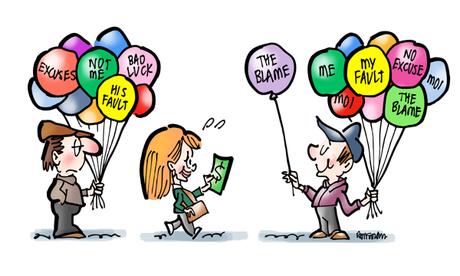 When I was a kid (we’re talking ancient history here), everyone knew the story about George Washington and
When I was a kid (we’re talking ancient history here), everyone knew the story about George Washington and
the cherry tree:
Little George, age 6 or so, was given a hatchet as a gift (toy departments were a lot different back then).

Naturally he wanted to try it out, so he chopped down a cherry tree his father had planted. When his father confronted him, George uttered his famous line:

“Father, I cannot tell a lie– it was I who chopped down
the cherry tree.”

Alas, the story’s just a myth, but like most myths it has an important lesson to teach: When you make a mistake, admit it.
The story came to mind when I contributed to an Databox article about communicating bad news, either to your boss or to a client. It’s not our mistakes that get us in trouble, it’s how we handle them.

Program manager Mary Hladio says we’re tempted to cover up mistakes because we know they can hurt our reputation. But doing so only compounds the mistake.

There are no secrets anymore. Coverups have destroyed many a career in both business and politics. Better to own your mistake and resolve it as quickly as possible. It’s the only sure way to rebuild trust.

Think about what goes through your mind when someone says: “I’m afraid I have bad news…” Dread, anxiety. Your heart starts to race. You’re about to be blindsided.

That kind of sudden, out-of-the-blue shock should never happen in business– not if you’re keeping everyone informed.

Here’s what I said in the Databox article:

Never try to blame circumstances, bad luck, or anyone else. Accept responsibility, apologize, and lay out your plan for correcting the situation.
More importantly: provide regular status reports that include unforeseen developments, unexpected problems, delays, etc, and any other signs of trouble brewing.
By keeping people informed, you at least prevent bad news from coming as a shock. The first rule of business: no surprises.
I love copywriter Alexander Porter‘s mantra: “Give credit. Take blame.” In fact, I stole it for the title of this post.

When things go wrong it’s natural to slip into self-defense mode. After all, 99% of mistakes are shared at some level.
But trying to assign blame elsewhere isn’t a long-term strategy worth pursuing. Even if you do convince your boss or manager that someone else carried the lion’s share of the blame, will your teammates want to work with you after that?
Jarie Bolander of JSY PR & Marketing adds the following:

“Any and all bad news should be communicated before a meeting. The meeting should be the place to figure out how to resolve the issue.”

Better yet, come to that meeting with an action plan. Chris Wilks of BrandExtract:

Most clients understand that the path to success is rarely
a straight line so don’t try to sugarcoat or spin results.
Instead, own it and deliver your plan or solution for fixing the problem. This will show your client that you’re proactively working to make their project a success, which
is why they hired you in the first place.
It’s important to note, too, that owning a problem doesn’t solve it. You may have to devote long hours to damage control and setting things right.

Mary Hladio also notes that admitting mistakes doesn’t mean you’ll somehow be immune to consequences.

Even if you do everything you can to be upfront, apologetic, and to fix the problem, you should know that that there may be fallout from what happened.
You will need to rebuild trust… the best thing you can do is to document lessons learned so the mistake is not made again by you or anyone else.
Speaking of apologies, author and coach Michael Hyatt says it’s important to show remorse for mistakes:

It doesn’t end with ownership… Our failings cause difficulty to others. Our mistakes cost time, money, and sometimes heartache.
We should express sorrow and regret for the hurt our behavior caused.

